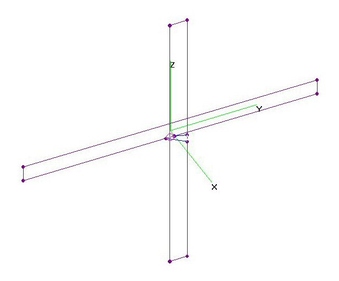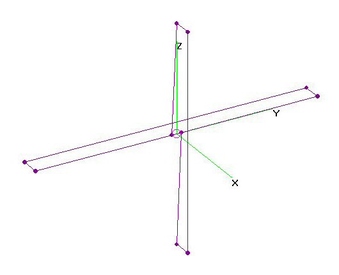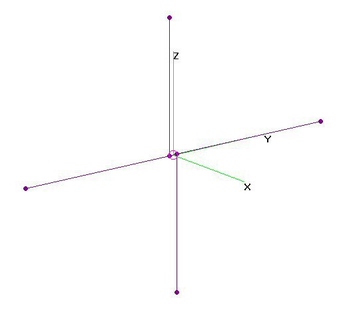 | 1.
Hi-VHF Crossed FD's - 2TL=QWL+HWL (4 Feb 2012)Hi-VHF Crossed Folded Dipoles (FD's) Yagi [Coincident, NO Offset] fed by two Unequal Transmission Lines,
Quarter-Wavelength and Half-Wavelength long respectively to provide requisite 90-deg phase shift
between FD's for Right Hand Circular Polarization (RHCP).
Poor Cross Polarization Loss on higher Hi-VHF channels and lack of LHCP suppression (Multipath) from REAR. |
| 2246 Visits
25 Images
Shared Album | |
|
 | 2.
Hi-VHF Crossed Folded Dipoles - TL=QWL (20 Jan 2012)Hi-VHF Crossed Folded Dipoles (Cross-FD's) with 450-ohms Impedance Interconnecting
Feedline = Quarter-Wavelength Long (simulated by a TL Card) analyzed using 4nec2.
[In diagrams below, Feedline is NOT TO SCALE.]
With Quarter-Inch Copper Tubing (QICT), 2-in FD "Width" (distance between FD Elements)
and 2-in Separation between the Crossed FD's, a large Gain and SWR GLITCH was found
in the middle of the Hi-VHF Band, the placement depending on the overall FD Length:
177 MHz if 32-in, 202 MHz if 28-in, 209 MHz if 27-in, etc.
If the length of the Cross-FD's are much longer or shorter than when used alone, the GLITCHES
can be moved out-of-band. FD Length = 34-in or 24-in was barely sufficient to avoid the
GLITCHES, as shown below. The longer 34-in FD had 0.5 dB higher Gain and only slightly higher SWR.
They are followed by results for FD Length =27-in with Gain and SWR GLITCHES at 209 MHz.
Note that Right Hand Circular Polarization is strongest FORWARD, while Left Hand is strongest to REVERSE,
so VERY CAREFULLY check antenna connections and alignment. Reversing one interconnection reverses Polarization.
Poor Cross Polarization Loss on higher Hi-VHF channels and lack of LHCP suppression (Multipath) from REAR. |
| 2296 Visits
75 Images
Shared Album | |
|
 | 3.
Hi-VHF Folded-Dipole-Pair - Cir. Polar. (16 Jan 2012)Hi-VHF Crossed Folded-Dipole-Pair with Right Hand Circular Polarization analyzed using 4nec2.
Derived from K6STI's VHF Dipole-Pair, found as cirdip3.nec in 4nec2's c:\nec2\models\VHFsimple
sub-directory, as well as here: http://heplx3.phsx.ku.edu/~dzb/antcal/nec-files/circdip3.nec.
Rescaled so that Left Hand Circular (Cross) Polarization is MINIMUM at 90-deg azimuth on 198 MHz.
Provides very good Right Hand Circular Polarization performance, with Left Hand (Cross) Polarization difference
between 7 dB (at band edges) and 20+ dB at 198 MHz. Gain is between 1.5 dBic (band edges) and 2.1 dBic at 198 MHz.
SWR (300-ohms) is excellent, under 2.0.
Note that Right Hand Circular Polarization is strongest FORWARD, while Left Hand is strongest to REVERSE,
so VERY CAREFULLY check antenna connections and alignment.
Poor Cross Polarization Loss on higher Hi-VHF channels and lack of LHCP suppression (Multipath) from REAR. |
| 2641 Visits
23 Images
Shared Album | |
|
 | 4.
Hi-VHF Dipole-Pair - K6STI's Cir. Pol. (16 Jan 2012)Hi-VHF Crossed Dipole-Pair with Right Hand Circular Polarization analyzed using 4nec2.
Derived from K6STI's VHF Dipole-Pair, found as cirdip3.nec in 4nec2's c:\nec2\models\VHFsimple
sub-directory, as well as here: http://heplx3.phsx.ku.edu/~dzb/antcal/nec-files/circdip3.nec.
Rescaled so that Left Hand Circular (Cross) Polarization is MINIMUM at 90-deg azimuth on 198 MHz.
Provides very good Right Hand Circular Polarization performance, with Left Hand (Cross) Polarization difference
between 6 dB (at band edges) and 20+ dB at 198 MHz. Gain is between 0.7 dBic (low freqs) and 2.1 dBic at 198 MHz.
SWR (75-ohms) is excellent, under 1.8.
Note that Right Hand Circular Polarization is strongest FORWARD, while Left Hand is strongest to REVERSE,
so VERY CAREFULLY check antenna connections and alignment.
Poor Cross Polarization Loss on high & low Hi-VHF channels and lack of LHCP suppression (Multipath) from REAR. |
| 2396 Visits
20 Images
Shared Album | |
| |